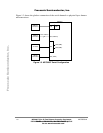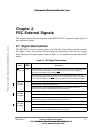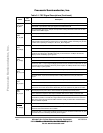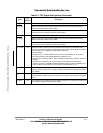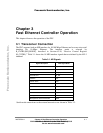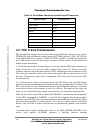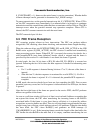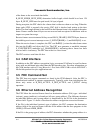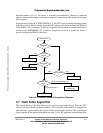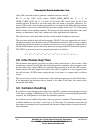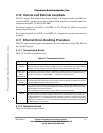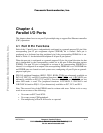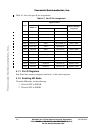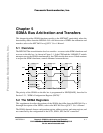
3-4 MPC860T (Rev. D) Fast Ethernet Controller Supplement MOTOROLA
PRELIMINARYÑSUBJECT TO CHANGE WITHOUT NOTICE
of the frame to the associated data buffer.
R_BUFF_SIZE[R_BUFF_SIZE] determines buffer length, which should be at least 128
bytes. R_BUFF_SIZE must be quad-word (16-byte) aligned.
During reception, the FEC checks for a frame that is either too short or too long. When the
frame ends (CRS is negated), the receive CRC Þeld is checked and written to the data
buffer. The data length written to the last BD in the Ethernet frame is the length of the entire
frame. Frames smaller than 64 bytes are not accessed and are rejected in hardware with no
impact on system bus usage.
Receive frames are not truncated if they exceed MAX_FRAME_LENGTH bytes, however
the babbling receive error interrupt occurs (I_EVENT[BABR] = 1) and RxBD[LG] is set.
When the receive frame is complete, the FEC sets RxBD[L], writes the other frame status
bits into the RxBD, and clears the E bit. The FEC next generates a maskable interrupt
(I_EVENT[RFINT] maskable by I_MASK[RFIEN]), indicating that a frame has been
received and is in memory. The FEC then waits for a new frame.
The FEC receives serial data lsb Þrst.
3.4 CAM Interface
In addition to the FEC address recognition logic, an external CAM may be used for frame
reject with no additional pins other than the MII interface pins. For more information on
the CAM interface refer to Using MotorolaÕs Fast Static RAM CAMs with the MPC860TÕs
Media Independent Interface application note.
3.5 FEC Command Set
The FEC does not support commands as found in the CPM channels. After the FEC is
initialized and enabled, it operates autonomously. Typically, aside from initialization, the
driver only writes to R_DES_ACTIVE, X_DES_ACTIVE, and I_EVENT during
operation.
3.6 Ethernet Address Recognition
The FEC Þlters the received frames based on destination address (DA) typeÑindividual
(unicast), group (multicast), or broadcast (all-ones group address). The difference between
an individual address and a group address is determined by the I/G bit in the destination
address Þeld. Figure 3-1 shows a ßowchart for address recognition on received frames.
If the DA is the individual (unicast) type of address, the FEC compares the destination
address Þeld of the received frame with the 48-bit address that the user programs in the
ADDR_LOW and ADDR_HIGH.
If the DA is the group type of address, the FEC determines whether the group address is a
Fr
eescale S
emiconduct
or
, I
Freescale Semiconductor, Inc.
For More Information On This Product,
Go to: www.freescale.com
nc...



